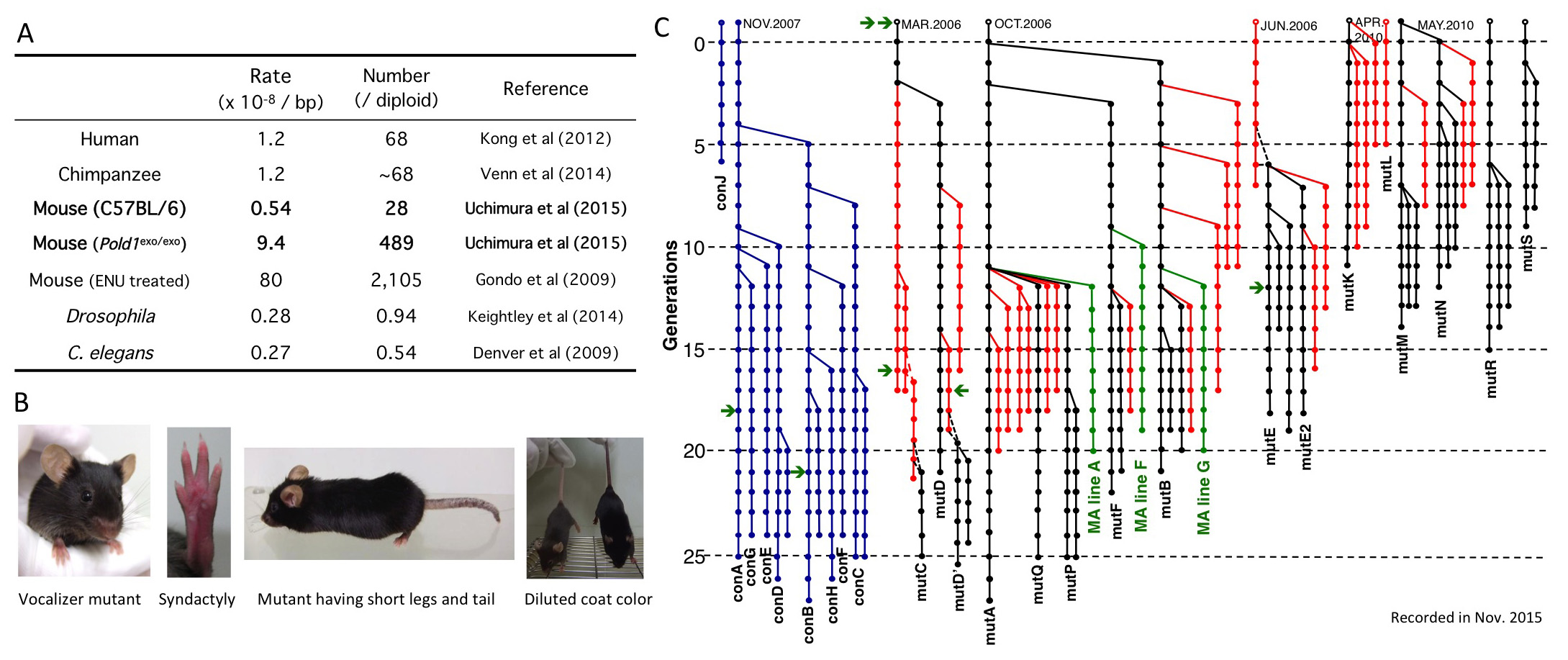|
Estimating germline mutation rate in laboratory mouse B6-Pold1<exo.uchi> (RBRC04293)Courtesy of Arikuni Uchimura, Ph.D. (A) Comparison of per generation mutation rate and the number of de novo mutations per generation. Uchimura and colleagues estimated the rate in laboratory mice by using mutation accumulation lines which they have established (shown in C). (B) Examples of phenotypic mutants, which were appeared from their mutation accumulation experiment and showed clear inheritance. Out of them, “Syndactyly mutant” was deposited as “sube” (RBRC02810) and “Vocalizer mutant” which emits human audible vocalization as B6-Singing<Osk> (RBRC04294, soon to be open). (C) Pedigrees of mutation accumulation lines (wild type and Pold1exo/exo [mutator] mice.) All breeding lines that were separated by six or more generations from the original line are shown: blue, wild-type; black, surviving mutator lines; red, extinct mutator lines; green, deposited lines in RIKEN BRC. Green arrows: whole-genome sequencing was performed on mice from the indicated generations (Uchimura et al. 2015). |
| Germline mutation is a fundamental resource for phenotypic variation, congenital disorders, and evolution. While mutation rate is a parameter to assess the risk of mutagens in germline and the mechanism of organism evolution, effect of accumulated mutation on mammalian population has been largely unclear. Uchimura and colleagues generated Pold1exo/exo mouse on a C57BL/6 background, which lacks 3’-5’ exonuclease activity of DNA polymerase delta [1]. They bred these mutator mice for more than 20 generations and performed whole-genome sequencing of different breeding lines [2]. Germline base-substitution mutation rate in laboratory mouse was estimated to be 5.4 × 10−9 (95% confidence interval = 4.6 × 10−9–6.5 × 10−9) and was about half the rate reported in human. Mutator mice showed variable phenotypes including human-audible vocalization, diluted coat color, and shortened limb and tail. Body weight as well as birth rate, litter size, and survival rate tended to decrease with increasing generations. This murator strain is a helpful tool to assume the risk of germline mutation in the mammalian population. |
| Depositor | : | Takeshi Yagi, Ph.D. KOKORO-Biology Group Laboratories for Integrated Biology Graduate School of Frontier Biosciences, Osaka University |
|
| Strain name | : | B6-Pold1<exo.uchi> | |
| RBRC No. | : | RBRC04293 | |
| Related strains in RIKEN BRC |
Please note that these strains may possess different genome and show different phenotypes from those described in the reference [2]. | ||
| Strain name | : | sube | |
| RBRC No. | : | RBRC02810 | |
| Strain name | : | B6-Singing<Osk> | |
| RBRC No. | : | RBRC04294 (soon to be open) | |
| Strain name | : | Mutation accumulation line A | |
| RBRC No. | : | RBRC04296 | |
| Strain name | : | Mutation accumulation line F | |
| RBRC No. | : | RBRC04828 | |
| Strain name | : | Mutation accumulation line G | |
| RBRC No. | : | RBRC04829 | |
| References | : | [1] | Uchimura A, Hidaka Y, Hirabayashi T, Hirabayashi M, Yagi T. DNA polymerase delta is required for early mammalian embryogenesis. PLOS ONE; 4(1):e4184, 2009. |
| [2] | Uchimura A, Higuchi M, Minakuchi Y, Ohno M, Toyoda A, Fujiyama A, Miura I, Wakana S, Nishino J, Yagi T. Germline mutation rates and the long-term phenotypic effects of mutation accumulation in wild-type laboratory mice and mutator mice.Genome Res.; 25(8):1125-34, 2015. | ||
| December 2015 Contact: Shinya Ayabe, Ph.D. Experimental Animal Division, RIKEN BioResource Center All materials contained on this site may not be reproduced, distributed, displayed, published or broadcast without the prior permission of the owner of that content. |






